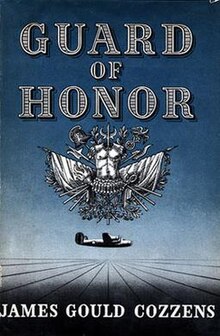
Twelve O'Clock High is a 1949 American war film directed by Henry King and based on the novel of the same name by Sy Bartlett and Beirne Lay, Jr. It stars Gregory Peck as Brig. General Frank Savage. Hugh Marlowe, Gary Merrill, Millard Mitchell, and Dean Jagger also appear in supporting roles.
Matthew Joseph Bruccoli was an American professor of English at the University of South Carolina. He was an expert on F. Scott Fitzgerald; his biography of Fitzgerald, published in 1981, was considered the standard biography for decades. He also wrote about other writers, including Ernest Hemingway, Thomas Wolfe, and John O'Hara, and was editor of the Dictionary of Literary Biography.

The Distinguished Flying Cross (DFC) is a military decoration of the United States Armed Forces. The medal was established on July 2, 1926, and is currently awarded to any persons who, after April 6, 1917, distinguish themselves by single acts of heroism or extraordinary achievement while participating in aerial flight. Both heroism and extraordinary achievement are entirely distinctive, involving operations that are not routine. The medal may be awarded to friendly foreign military members in ranks equivalent to the U.S. paygrade of O-6 and below in combat in support operations.
James Gould Cozzens was a Pulitzer prize-winning American writer whose work enjoyed an unusual degree of popular success and critical acclaim for more than three decades. His 1949 Pulitzer win was for the WWII race novel Guard of Honor, which more than one critic considered one of the most important accounts of the war. His 1957 Pulitzer nomination was for the best-selling novel By Love Possessed, which was later made into a popular 1961 film.

The Freeman Field mutiny was a series of incidents at Freeman Army Airfield, a United States Army Air Forces base near Seymour, Indiana, in 1945 in which African American members of the 477th Bombardment Group attempted to integrate an all-white officers' club. The mutiny resulted in 162 separate arrests of black officers, some of them twice. Three were court-martialed on relatively minor charges. One, Roger C. Terry, was convicted. In 1995, the Air Force officially vindicated the actions of the African-American officers, set aside the single court-martial conviction and removed letters of reprimand from the permanent files of 15 of the officers. The mutiny is generally regarded by historians of the Civil Rights Movement as an important step toward full integration of the armed forces and as a model for later efforts to integrate public facilities through civil disobedience.

A colonel in the United States Army, Marine Corps, Air Force and Space Force, is the most senior field-grade military officer rank, immediately above the rank of lieutenant colonel and just below the rank of brigadier general. Colonel is equivalent to the naval rank of captain in the other uniformed services. By law, an officer previously required at least 22 years of cumulative service and a minimum of three years as a lieutenant colonel before being promoted to colonel. With the signing of the National Defense Authorization Act of 2019, military services now have the authorization to directly commission new officers up to the rank of colonel. The pay grade for colonel is O-6.

Riverside National Cemetery (RNC) is a cemetery located in Riverside, California, dedicated to the interment of United States military personnel. The cemetery covers 921 acres (373 ha). It has been the most active cemetery in the system since 2000, based on the number of interments.
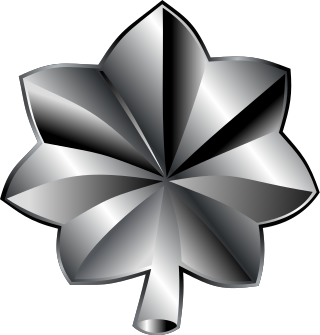
In the United States Army, Marine Corps, Air Force and Space Force, lieutenant colonel is a field-grade officer rank, just above the rank of major and just below the rank of colonel. It is equivalent to the naval rank of commander in the other uniformed services.

Frank Alton Armstrong Jr. was a lieutenant general of the United States Air Force. As a brigadier general in the United States Army Air Forces during World War II, he was the inspiration for the main character in the novel and subsequent film, Twelve O'Clock High. After the war, he held a variety of senior leadership positions prior to and following the establishment of the USAF as an independent service in 1947. Promoted to major general in 1950, he advanced to lieutenant general in 1956 and retired at that rank in 1961.
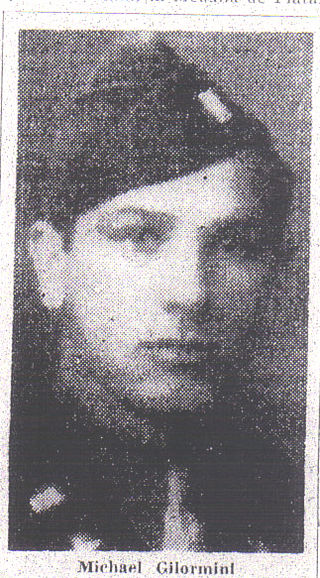
Brigadier General Mihiel "Mike" Gilormini Pacheco was a United States Air Force officer who served in the Royal Air Force and in the United States Army Air Forces during World War II. He was the recipient of the Silver Star, the Air Medal with four clusters and the Distinguished Flying Cross 5 times. He was also a co-founder of the Puerto Rico Air National Guard.

Hispanic Americans, also referred to as Latinos, served in all elements of the American armed forces in the war. They fought in every major American battle in the war. Between 400,000 and 500,000 Hispanic Americans served in the U.S. Armed Forces during World War II, out of a total of 16,000,000, constituting 3.1% to 3.2% of the U.S. Armed Forces. The exact number is unknown as, at the time, Hispanics were not tabulated separately, but were included in the general white population census count. Separate statistics were kept for African Americans and Asian Americans.

By Love Possessed is a novel written by James Gould Cozzens in the middle 1950s. It was published on August 26, 1957, by Harcourt Brace and Company, and became a critically acclaimed best-seller. In 1960, it was awarded the William Dean Howells Medal, an award given every five years to the best novel of the previous five years.
Stalag Luft I was a German World War II prisoner-of-war (POW) camp near Barth, Western Pomerania, Germany, for captured Allied airmen. The presence of the prison camp is said to have shielded the town of Barth from Allied bombing. About 9,000 airmen – 7,588 American and 1,351 British and Canadian – were imprisoned there when it was liberated on the night of 30 April 1945 by Soviet troops.

Major General Chesley G. Peterson was a career officer in the United States Air Force, and a flying ace of the United States Army Air Forces (USAAF) in World War II. As a fighter pilot in the European theater, he is best known for his time as the commander of the famous 4th Fighter Group during 1942–1943. At 23, he was the youngest colonel in the USAAF.
Hispanics in the United States Air Force can trace their tradition of service back to the United States Army Air Forces (USAAF), the military aviation arm of the United States Army during and immediately after World War II. The USAAF was the predecessor of the United States Air Force, which was formed as a separate branch of the military on September 18, 1947, under the National Security Act of 1947. In the U.S., the term Hispanic categorizes any citizen or resident of the United States, of any racial background, of any country, and of any religion, who has at least one ancestor from the people of Spain or is of non-Hispanic origin but has an ancestor from Mexico, Puerto Rico, Cuba, Central or South America, or some other Hispanic origin. The three largest Hispanic groups in the United States are the Mexican-Americans, Puerto Ricans, and Cubans. According to the U.S. Census Bureau the estimated Hispanic population of the United States is over 50 million, or 16% of the U.S. population, and Hispanics are the nation's largest ethnic minority. The 2010 U.S. census estimate of over 50 million Hispanics in the U.S. does not include the 3.9 million residents of Puerto Rico, thereby making the people of Hispanic origin the nation's largest ethnic or race minority as of July 1, 2005.
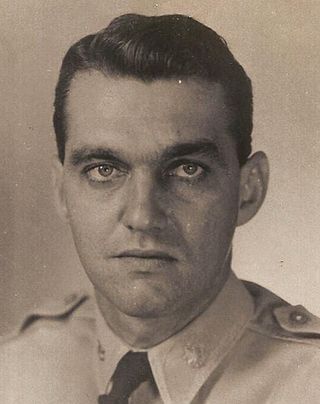
Lieutenant Colonel José Antonio Muñiz was a United States Air Force officer who during World War II served in the United States Army Air Forces. He co-founded the Puerto Rico Air National Guard together with then-Colonels Alberto A. Nido and Mihiel Gilormini. In 1963, the Air National Guard Base, at the San Juan International Airport in Puerto Rico, was renamed "Muñiz Air National Guard Base" in his honor.

The 3rd Texas Cavalry Regiment or South Kansas-Texas Mounted Volunteers was a unit of mounted volunteers that fought in the Confederate States Army during the American Civil War. The regiment fought at Wilson's Creek and Chustenahlah in 1861, Pea Ridge, Corinth siege, Iuka, Second Corinth, and the Holly Springs Raid in 1862, Thompson's Station in 1863, and at Yazoo City, in the Atlanta campaign, and at Nashville in 1864. The regiment fought dismounted at Iuka and Second Corinth before being remounted for the rest of the war. The regiment surrendered to Federal forces in May 1865 and its remaining 207 men were paroled.

The 6th Texas Cavalry Regiment was a unit of mounted volunteers that fought in the Confederate States Army during the American Civil War. The regiment fought at Chustenahlah in 1861. The following year the unit fought at Pea Ridge, First Corinth, Second Corinth, Hatchie's Bridge, and Holly Springs. The 6th Texas Cavalry participated in the fighting at Thompson's Station in 1863, the Atlanta campaign, and the Franklin–Nashville Campaign in 1864. The regiment formally surrendered to Union forces in May 1865 and its remaining soldiers were paroled.
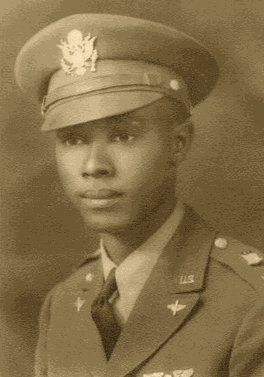
Mac Ross was a U.S. Army Air Force officer and combat fighter pilot during World War II. A member of the Tuskegee Airmen, he commanded the 100th Fighter Squadron and served as the Group Operations Officer for the 332nd Fighter Group.
Carl Croston Johnson was an American U.S. Army Air Force and U.S. Army officer, and former Cleveland, Ohio Airport Commissioner and deputy director of the Pittsburgh International Airport.
